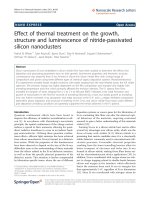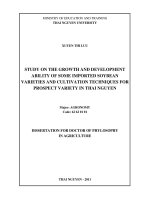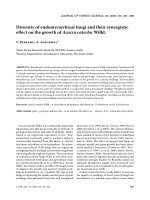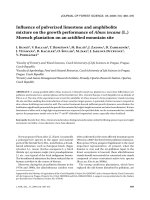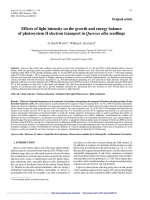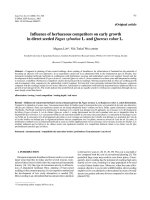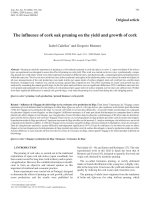Effects of time and level of pruning on the growth and flowering of Jasminum sambac (L.) Cv. Gundumalli
Bạn đang xem bản rút gọn của tài liệu. Xem và tải ngay bản đầy đủ của tài liệu tại đây (239.56 KB, 9 trang )
Int.J.Curr.Microbiol.App.Sci (2019) 8(8): 2455-2463
International Journal of Current Microbiology and Applied Sciences
ISSN: 2319-7706 Volume 8 Number 08 (2019)
Journal homepage:
Original Research Article
/>
Effects of Time and Level of Pruning on the Growth and Flowering of
Jasminum sambac (L.) Cv. Gundumalli
Sushree Choudhury*, Jatindra Nath Das, Prabhasini Behera
Department of floriculture and landscaping, College of Agriculture,
Orissa University of Agriculture and Technology, Bhubaneswar-751003, Odisha, India
*Corresponding author
ABSTRACT
Keywords
Jasminum sambac,
Pruning months,
Growth, Flowering
and yield
Article Info
Accepted:
22 July 2019
Available Online:
10 August 2019
An investigation was carried out during (2014-16.) at the garden of the Department of
floriculture and landscaping, College of Agriculture, OUAT, Bhubaneswar to study the
Effects Of Different Time And Level Of Pruning On The Growth, Flowering And Yield
Of Jasminum Sambac (L.) Aiton with sixteen treatment combinations in Factorial
Randomised Block Design with three replications. The treatments comprised four timings
of pruning viz., 2nd week of September,2 nd week of October,2nd week of November,2nd
week of December and four levels of pruning viz.,20,40,60,80cm above ground level .
Among the four levels of pruning, 40 cm from the ground level showed the best result with
respect to productive shoots/plant(57.71) maximum flower yield(14.97t/ha). Pruning
during 2nd week of November reached the highest primary shoot length (108.82 cm),
number of productive shoots/plant (57.04) and maximum yield (15 t/ha in Jasminum
sambac whereas, lowest yield (10.58t/ha) was observed in September pruning. In case of
interaction effect of different pruning time and pruning level was found non-significant
with respect to all vegetative growth and flowering parameters except number of sprouts,
yield of flower buds per hector
Introduction
Flower is the symbol of beauty, love and
tranquility, flower conveys the message of
love, joy and affection. In beautification,
flowers are one of the main ingredients since
the beginning of history and its importance
has not yet diminished but rather increased as
time proceeds. Among the commercial
flowers grown in India the most important are
roses,
carnation,
gerbera,
orchid,
chrysanthemum, jasmine, marigold, aster etc.
Jasmine (Jasmine sambac L.) is a very
important group of plants, belongs to family
Oleaceae. It is naturally distributed in Andhra
Pradesh, Karnataka and TamilNadu and to
some extent in West Bengal states of India
(Randhawa and Mukhopadhyay, 1986) which
is cultivated extensively in tropical and subtropical areas of Southeast Asia and other
parts of world for garden decoration and
commercial purposes. In Fragrance industry,
jasmine has unique importance and popularity
due to its unique sweet fragrance like that of
2455
Int.J.Curr.Microbiol.App.Sci (2019) 8(8): 2455-2463
rose, vetiver and represents a type that cannot
be exactly imitated at present by a mixture of
any known synthetic aroma chemicals or
natural isolates The extracts of jasmine are
used for flavoring or preparation of ‘Jasmine
scented Tea' in China and ‘Jasmine rice' in
Bangkok,
Thailand.
The
antioxidant
properties has the potential to induce weight
loss and to reduce serum and hepatic lipid
levels through the increase of leptin level
which address the burning problems of
fattiness and obesity (Li Zhen et al., 2011).
Jasmine will definitely emerge as an
important
"Industrial
flower
crop"
(Bhattacharjee,1980). The essential oil is
being used in cosmetics, perfumery and as a
source of aroma chemicals and food flavoring
industries. Jasmine flower crop is grown on
commercial scale throughout India, but
extensively in Tamil Nadu (12590 ha area and
1, 30, 070 MT production, 2015-16),
Karnataka (5760 ha area 3, 69,200 MT),
Andhra Pradesh (2710 ha area and 1, 51,300
MT).
Being industrial flower crop large quantities
of flowers need to be produced continuously
for a longer period of the year to meet the
break-even production of the essential oil
industry. The large quantitative production
requirement can be achieved by area
expansion and increasing productivity, by
adopting improved horticultural practices like
training, pruning, irrigation, use of optimum
dose of manures and fertilizers, inter cultural
operation, staking, plant protection etc. are
required to be properly followed
One of the important cultural operations in
Jasmine is pruning, which requires regular
pruning to encourage more number of shoots
and sprouting of dormant buds. It helps in
utilization of energy by elimination of
unwanted shoots. It is important for
rejuvenation of old plants, and maintenance of
floriferousness, increases flower size and
quality along with vigor of jasmine plant.
(Gibson, 1984; Anderson, 1991). The main
object of pruning jasmine plant is to remove
the unproductive growth, ensure production
of large number of strong and healthy shoots,
which will bear flowers and improve the
quality of blooms. Pruning encourages growth
of new healthy shoots which bear more
flowers than an old branch. It keeps the plants
in shape and form
The best time of pruning is the period when
the activity of the jasmine plant is least and
the plant is at dormant to near dormant stage...
The pruning date and pruning intensity also
influences quality and quantity of flower
production. Regulation of flowering in
jasmine has great commercial and practical
value due to seasonal nature of flowering and
peak productivity confined to certain months
of the year that is a major problem in jasmine
flower production. Pruning done at right time
and in specific amount provide fuel for the
initiation of flowering by sufficient
ventilation leading to least susceptibility of
plant to diseases. Hence, present investigation
was carried out to study the effect of time and
level of pruning on growth and flowering of
Jasmine (jasminum sambac (l.) aiton
Materials and Methods
The present investigation was undertaken at
the garden of the Department of floriculture
and landscaping, College of Agriculture,
Odisha University of Agriculture and
Technology, Bhubaneswar during two
consecutive years (2014-15 and 2015-16.) to
study the Effects Of Different Time And
Level Of Pruning On The Growth, Flowering
And Yield Of Jasminum Sambac (L.) Aiton
with sixteen treatment combinations in
Factorial Randomised Block Design with
three replications.
The treatments comprised of four different
2456
Int.J.Curr.Microbiol.App.Sci (2019) 8(8): 2455-2463
time of pruning viz i.e 10th September 10th
October, 10th November, 10th December and
at four levels of severity of pruning viz 20,
40, 60, 80 cm from the ground level by
keeping uniform number of branches. The
three year old bushes of Gundu malli variety
of jasmine were pruned according to the
treatment schedule to a level of 20, 40, 60, 80
cm cm above ground level. Immediately after
pruning, the FYM and chemical fertilizers
were applied
at a dose of 14:7:7gm
NPK/plant at 15 cm deep and 20 cm away
from the main stem in the rings and covered
with soil. The urea, single super phosphate
and murate of potash were used as the sources
of nutrient elements. All the cultural
operations viz., weeding, irrigation, pest
control etc. were carried out as and when
required.
Five randomly selected plants were tagged
per replication in each treatment and
observations were recorded for vegetative
growth and flowering and data were recorded
for two consecutive years (2014-15 and 201516.) The pooled analysis of two years data
was carried out as per the method suggested
by Fisher (1954) and Pansy and Sukhatme
(1967).
that significantly maximum sprouts (191.73)
was found in plants pruned in November(T3)
which was statistically at par with the plants
pruned in October (T2) and minimum number
of sprouts (160.48) was recorded in the plants
pruned in December (T4). Significantly
maximum number of sprouts (195.99) was
noted in the plants pruned at 40 cm from the
ground level (L2) Whereas, minimum number
of sprouts (144.81) was recorded by the plants
pruned at 80 cm above ground level (L4). The
data revealed that interaction effect of
different pruning time and pruning level
showed significant result with respect to
number of sprouts.
Primary shoot length
Maximum length of primary shoot (108.82
cm) was recorded in plants pruned in T3
which is significantly superior over all other
treatments and minimum (100.52cm) was
found in bushes pruned in T4 at 90 days after
pruning. Significantly longest primary shoot
(127.91cm) was noted in plants pruned at H2,
while shortest primary shoot (75.94 cm) was
obtained in plants pruned at L1 at 90 days.
Various combinations of pruning time and
pruning levels had no significant influence on
this parameter.
Results and Discussion
Shoot thickness
The experimental results of the present
investigation
on
various
vegetative
parameters are recorded for two years and the
pooled analysis of two years data are
represented in Table1
Growth characteristics
Significantly maximum Shoot thickness
(1.08cm) was recorded in plants pruned in T3
and minimum (0.97 cm) was noted in the
plants pruned in T4. Significantly maximum
Shoot thickness (1.13cm) was noted in plants
pruned at L3, while minimum (0.89 cm) was
obtained in plants pruned at a height of L4.
Number of Sprouts per plant
Number of leaves per primary Shoot
A perusal of data presened1 regarding number
of Sprouts per plant at 28 days after pruning
as influenced by different pruning time was
found significant. It is evident from the data
The data resulted that the significantly
maximum number of leaves per primary shoot
(118.76) was observed in plants pruned in T3
2457
Int.J.Curr.Microbiol.App.Sci (2019) 8(8): 2455-2463
and minimum (106.46) in T4. Significantly
highest number leaves per primary shoot
(117.75) were noted in plants pruned at L2.
While least number of leaves per primary
shoot (106.46) was obtained in plants pruned
at 80 cm from ground level (L4).
Number of laterals per primary shoot
The data resulted that the significantly more
number of laterals per primary shoot (9.79)
was observed in plants pruned in T3 a on the
other hand minimum (7.91) in T3.
Significantly highest numbers of laterals per
primary shoot (10.86) were noted in plants
pruned at a height of 40cm (L2). While least
number of laterals per primary shoot (7.91)
was obtained in plants pruned at 80 cm from
ground level (L4) interaction of pruning time
and pruning levels had no significant
influence on this parameter
Productive shoots/plant
Significant difference in number of
productive shoots/plant. November pruned
plants T3 recorded maximum number of
productive shoots (57.04 and minimum
(45.02) in T4. The plants pruned at a height of
40cm (L2) recorded maximum (57.71) and
minimum (45.02) was observed in L4.
Flowering characteristics
Days taken to first flower bud initiation: The
data related to number of days taken for first
flower bud initiation was influenced
significantly by pruning time. The plants
pruned during December (T4) were the
earliest for flower bud initiation (42.77 days)
while late flower bud initiation (61.27 days)
was observed in plants pruned in September
(T1). The perusal of the data revealed that
earlier flower bud initiation was observed
significantly in plants pruned at 60 cm from
the ground level (L3) with 45.09 days.
Whereas, plants pruned from 80 cm above
ground level (L4) noted late flower bud
initiation with 61.75days.
Days taken for full development of flower:
Early development of flower (14.63days) was
noted in plants pruned during December (T4)
while late development of flower (16.06days)
was observed in plants pruned in pruned in
September (T1). In case of level of pruning,
early development of flowering was observed
significantly in plants pruned L3 with
15.07days, while in L1 pruning level noted
late flower bud initiation with 15.74 days.
Duration of flowering (days): The data
indicated
that
significantly
longer
duration(134.77days) of flowering was
recorded in T1 while the shortest
duration(115.21days) was recorded in T4. In
case of level of pruning, significant difference
was noticed with respect to this parameter.
Longest duration of flowering (146.92 days)
was recorded in H2 whereas shortest duration
of flowering (104.46) was observed in H4
Flower bud length: The data indicated that
flower
bud
length
was
influenced
significantly by pruning time. Longest flower
bud length (3.44cm) was noted in plants
pruned in November (T3) However, shortest
flower bud length (3.11cm) was reported in
plants pruned in December (T4). At the
pruning level, the result stated that flower bud
length was observed significantly maximum
in plants pruned at 40 cm from the ground
level (L2) with (3.37cm), while plants pruned
from 80cm ground level (L4) noted minimum
flower bud length (3.23 cm).
Diameter of flower bud: The maximum
diameter of flower bud (0.97cm) was noted in
plants pruned in T3, while minimum diameter
of flower bud (0.85 cm) was observed in
plants pruned in T4. The data revealed that
flower bud diameter was observed
2458
Int.J.Curr.Microbiol.App.Sci (2019) 8(8): 2455-2463
significantly maximum (0.95cm) in plants
pruned at L2, whereas minimum flower bud
diameter (0.85 cm) noted in plants pruned at
L3.
Weight of fifty flowers buds: Significantly
maximum weight of fifty flowers (16.05 g)
was noted in plants pruned in T3, while
minimum weight of fifty flowers (15.50 g)
was observed in plants pruned in T1. In case
of pruning level, It is evident from the data
that weight of fifty flowers was observed
significantly maximum in plants pruned L2
with (16.08 g), while plants pruned at L4
noted minimum weight of fifty flowers (15.15
g).
Flower yield/hector: Significantly highest
flower yield (15.00tonn) was noted in plants
pruned in T3, while lowest yield (10.59 ton)
was observed in T1. In case of pruning level
L2 maximum flower yield (14.97t) and
minimum yield of (10.35t) was recorded in
L13.261
Interaction effect
The data indicated that the interaction effect
between both the factors (time of pruning and
level of pruning) was found non- significant
for all the studied parameters except yield of
flower buds per hector.
Table.1 Effect of time and level of pruning on vegetative growth of Jasminum sambac (L.)
(Pooled means)
TREATMENTS
Number of Length of Shoot
Leaves
Sprouts
primary
thickness /plant
per plant
shoot(cm)
FACTOR A-TIME OF PRUNING
T1: 2nd week of September 170.61
185.66
T2: 2nd week of October
nd
T3: 2 week of November 191.73
T4: 2nd week of December 160.48
1.93
SE (m) ±
5.58
CD 5%
FACTOR B-LEVEL OF PRUNING
174.54
L1-20cm above GL
195.99
L2-40cm above GL
193.14
L3-60cm above GL
144.81
L4-80cm above GL
1.93
SE (m) ±
5.58
CD 5%
INTERACTION EFFECT (TXL)
3.86
SE (m) ±
11.16
cod 5%
S
F TEST
Number of productive
laterals per shoots/plant
primary
shoot
103.42
103.41
108.82
100.52
1.57
4.53
0.99
1.04
1.08
0.97
0.01
0.03
112.21
112.13
118.76
106.46
1.45
4.19
8.65
9.11
9.79
7.91
0.13
0.37
48.28
53.73
57.04
45.02
0.64
1.85
75.94
97.57
114.76
127.91
1.57
4.53
1.01
1.13
1.04
0.89
0.01
0.03
112.98
117.74
112.76
106.07
1.45
4.19
9.57
10.86
8.45
6.57
0.13
0.37
52.65
57.71
47.37
46.34
0.64
1.85
3.140
NS
0.02
NS
2.90
NS
0.26
NS
1.28
NS
N.B: S: Significant, NS: Non Significant, GL: Ground level
2459
Int.J.Curr.Microbiol.App.Sci (2019) 8(8): 2455-2463
Table.2 Effect of time and level of pruning on flowering, yield, quality of Jasminum sambac
(L.)(Pooled means)
TREATMENTS
Initiatio
n of
flower
bud
(Days)
FACTOR A-TIME OF PRUNING
T1:
2nd
week
of 61.27
September
57.32
T2: 2nd week of October
nd
T3:
2
week
of 51.70
November
T4:
2nd
week
of 42.77
December
0.94
SE (m) ±
2.71
CD 5%
FACTOR B-LEVEL OF PRUNING
55.71
L1-20cm above GL
50.51
L2-40cm above GL
45.09
L3-60cm above GL
61.75
L4-80cm above GL
0.94
SE (m) ±
Full
developme
nt of
flower
(Days)
Duration
of
flowering
(Days)
Flower
bud
length
(cm)
Diameter
of flower
bud
(cm)
Weight
of fifty
flowers
buds
(gm)
Flower
yield of
/ha
(ton)
16.06
134.77
3.33
0.90
15.50
10.58
15.43
14.89
130.36
124.62
3.39
3.44
0.93
0.97
15.77
16.05
12.30
15.00
14.63
115.21
3.11
0.85
16.02
13.26
0.20
0.59
1.89
5.48
0.02
0.07
0.01
0.03
0.64
1.85
0.16
0.48
15.74
15.08
15.07
15.13
0.20
131.07
146.91
122.53
104.46
1.89
3.31
3.36
3.37
3.23
0.02
0.94
0.95
0.92
0.85
0.01
16.05
16.08
16.06
15.15
0.18
13.38
14.97
12.45
10.35
0.16
2.71
CD 5%
INTERACTION EFFECT (TXL)
1.38
SE (m) ±
CD5%
NS
F TEST
0.59
5.48
0.07
0.37
0.53
0.48
3.79
NS
3.79
NS
0.05
NS
0.02
NS
0.36
NS
0.33
0.96
S
Figure.1 Percentage increase in number of productive shoots by the influence of time and levels
of pruning
2460
Int.J.Curr.Microbiol.App.Sci (2019) 8(8): 2455-2463
Figure.2 Percentage increase in flower yield by the influence of time and levels of pruning
Effect of time and levels of pruning
The factors responsible for growth and flower
quality in a plant are depending upon climate,
soil, cultural manipulations and their
interactions. Pruning time and pruning level
play a prime role in deciding the growth and
quality of plant, flowers in the jasmine.
Knowledge on this aspect is of paramount
importance to manipulate the plants
physiology, which may eventually lead to the
maximum production. Vegetative growth
characteristics were resulted due to an
availability of suitable climatic condition. The
plants pruned during Second week of
November produce maximum primary shoot
length and thickness. This may be due to
increase in light intensity as well as aeration,
diversion of sap flow towards lateral buds
after pruning. The results are also
substantiated the findings of Ratikanth (2005)
in Jasminum sambac under Karnataka
condition and lokhande et al., (2015) in
Jasmine. Earlier studies have also found that
plants pruned in November month contents
more total polysaccharide, which resulted
high number of leaves in Jasminum sambac
(Sumangala et al., 2003). Pruning in second
week of December (T4) in J. sambac bushes
triggered early flower bud initiation
(42.77days and Days taken for full
development of flower (14.63days) (Table2).
It might be due to the juvenile phase in late
pruning was less compared to other
treatments. The jasmine bushes pruned in
December month produced late flowering due
to low temperature and shorter sun shine
hours. Similar trend was also observed by
Gowda et al., (1986) in Jasminum
auriculatum and Sujatha et.al (2009) and
lokhande et al., (2015) in J. sambac.
Significantly larger flower bud with respect to
diameter of bud (0.97cm) and bud length
(3.44cm) were obtained by plants pruned in
November (T3). The better flower size was
obtained due to better vegetative growth,
congenial climatic condition and production
of large quantity of reserve food as compared
to other months of pruning. The results
obtained are in close agreement with the
findings of Khattak et al., (2011) due to
pruning time in Rose. Similarly, finding of
weight of fifty flower buds were also
agreement of the findings of Sumangala et al.,
(2003) in Jasminum sambac.
It is evident from the table1 and 2;
significantly
longest
primary
shoot
(127.91cm) was noted in plants pruned at
level of 80 cm (L4) while shortest primary
shoot (75.94 cm) was obtained in plants
pruned at 20 cm (L1) at 90 days after pruning
2461
Int.J.Curr.Microbiol.App.Sci (2019) 8(8): 2455-2463
it might be due to higher initial height and
high polysaccharide content in plants. Similar
trend was found by Zekavati (2013) in rose.
Pruning encourages the shoot length but serve
as well as minimum pruning discourage the
shoot length (Sharma and Singh, 1991) and
pruning reduces apical dominance and
enhances lateral growth of plant. This might
have been the reason for increasing length of
primary shoot, leaf area and number of
secondary laterals per primary shoot in
jasmine. Similar results were obtained by
Santhoshini (2014) in rose under Nagpur
(M.S.) conditions. More number of leaves
might be produced due to increased light
intensity and good aeration caused by
pruning. The results are in close conformity
with the findings of Zekavati (2013) in rose
and Chopde et al., (2017) in jasmine. Early
emergence of first flower bud (45.09days) and
early development of flowering (15.07 days)
was observed significantly in plants pruned at
a level of 60 cm (L3) from ground level. This
could be due to the fact that pruning helps to
broaden the C/N ratio, thus stimulating
flowering and increasing vigor of plant as a
result of adequate pruning level. The results
are in close agreement with the findings of
Ghulam et al., (2004)in rose and lokhande et
al., (2015) in jasmine. Highest length and
diameter of flower bud and 50 flower bud
weights, flower yield was observed in the
plants pruned at a level of 60 cm (L3) could
be due to increased availability of
photosynthetic due to enhanced vegetative
growth of plant which might have been
diverted to the sink and utilized for the
production of better quality flowers as well as
more flower yield. The results are in line with
the findings of Porwal et al., (2002) in 8 yearold-damask rose (Rosa damascena) Ghulam et
al., (2004) in rose, Adnan et al., (2013) in
Rosa centifolia and lokhande et al., (2015) in
jasmine. Percentage higher yield as effected
by interaction of time and level of pruning
Interaction effect (T x L)
The interaction effect of different pruning
time and pruning level was found nonsignificant for the growth and flowering
characteristics due to the climatic conditions..
By the influence of time and levels of pruning
the number of productive shoots increase by
63.2 percentage and flower yield by 110.10
pecentage
over
(T4L4)
and
(T3L2)respectively when the plants pruned
during November at a height of 40cm from
ground level i.e.T3L2 (Fig1 andFig2). The
results are in agreement with the earlier
findings of Lokhande et al., (2015) and
Chopde et al., (2017)
It was concluded that pruning of Jasminum
sambac var. Gundumalli during second week
of November at 40 cm above ground level is
beneficial for better growth and flower traits
with good quality of jasmine flowers. This is
due to change in weather conditions like
change in temperature and day length
prevailed during November month. Hence,
according to changes in weather the pruning
month should be changed to get an ample
production and yield in Jasminum sambac
Acknowledgement
The authors wish to thanks Research guide
and Head, Department of floriculture and
landscaping, College of Agriculture, Odisha
University of Agriculture and Technology,
Bhubaneswar for providing necessary facility
in conducing the experiment
References
2462
.Porwal, R., C. L. Nagda and J. P. S. Pundir
(2002). Effect of pruning severity on the
vegetative growth, flower yield and oil
content of damask rose. J. Applied Hort.,
4(1): 37- 40.
.Santhoshini, C. N. R. (2014). Response of
rose varieties to pruning severity under
Int.J.Curr.Microbiol.App.Sci (2019) 8(8): 2455-2463
open conditions. M.Sc. (Hort.) thesis
(unpub.) submitted to Dr.Panjabrao
Deshmukh Krishi Vidyapeeth, Akola
(M.S.).
Adnan, Y, A. Riaz, S. Aslam, M. Ahsan, U.
Tariq, F. Javaid, M. Nadeem and M.
Hameed (2013). Effect of different
pruning dates on growth and flowering of
Rosa centifolia. Pakistan J. Agri. Sci.,
50(4): 605-609
Anderson GA. Characteristics of English roses
during their first year of establishment.
Special Circular - Ohio Agri. Res. Dev.
Cent. 1991; 137:28-29.
Bhattacharjee, S.K., (1980). Native Jasmine of
India. Indian perfumer, 24 (3): 126- 133
Chopde Neha, Lokhande Sushma, Bhande
MH, Warkade VP. Impact of time and
level of pruning on growth and flowering
of Jasminum sambac (L.). Res. Crops.
2017; 18(1):123-128.
Fisher, R. A. (1954). Statistical Methods for
Research Workers. London, Oliver and
Boyed Ltd
Ghulam Z, Muhammad M, Qasim M, Jamil M,
Jalalud- Din B. Effect of extent of
pruning on growth and flowering
characteristics of six exotic rose
cultivars. Sarhad J Agri. 2004;
20(4):501-506.
Gibson M. Growing roses. Croom Helm Ltd.,
Provident
House,
Burrell
Row,
Beckenham, Kent, England, 1984.
Gowda J, Sulladmath UV, Jayanthi R. Studies
on effect of staggered pruning in
Jasminum auriculatum. Current Res.
1986; 15(10):106-107.
Khattak AM, Dawar SH, Razaq A. Effect of
summer pruning on the quality and
performance of rose cultivars. Sarhad J
Agri. 2011; 27(1):27-31.
Li Zhen, Lin Cong, Tao Zhao. The effects of
Jasmine tea on nutritional physiological
functions of growing rats. Modern
Preventive Medicine. 2011; 38(3):456460.
Lokhande S, Chopde N, Wasnik P, Nehare N.
Response of Jasminum sambac L. to time
and severity of pruning. Plant Archives.
2015; 15(2):759-762.
Pansy VG, Sukhatme PV. Statistical Methods
for Agricultural Workers. Publication
and Information Division, ICAR, New
Delhi, 1967.
Randhawa GS, Mukhopadhyay A. Floriculture
in India, Allied Publishers P Ltd,
Mumbai, 1986.
Ratikanth. Standardization of time of pruning
and nutrition on growth and yield of
Jasminum Sambac var. Mangalore
Mallige. Karnataka J of Agri. Sci. 2005;
19(1):229.
Sharma CK, Singh IP. Response to amount of
pruning of the growth and flowering of
Jasminum sambac in cv. Gundumali.
Haryana J Horti. Sci. 1991; 20(3-4):176182.
Sujatha Nair A, Sujatha K, Venugopalan R.
Influence of pruning time on enhancing
the yield and quality of Jasminum
sambac flowers during the off-season.
Indian J Agri. Sci. 2009; 79(11):857-860
Sumangala HP, Patil VS, Rao MM. Effect of
time of pruning on Jasminum sambac. J
Ornamental Horti. (New Series). 2003;
6(2):137-138.
Zekavati HA. Effect of time and severity of
pruning on growth and branch
development of rose (Rosa spp), Asian J
Agric. Sci. 2013; 6(3):79
How to cite this article:
Sushree Choudhury, Jatindra Nath Das, Prabhasini Behera. 2019. Effects of Time and Level of
Pruning on the Growth and Flowering of Jasminum sambac (L.) Cv. Gundumalli.
Int.J.Curr.Microbiol.App.Sci. 8(08): 2455-2463. doi: />
2463


